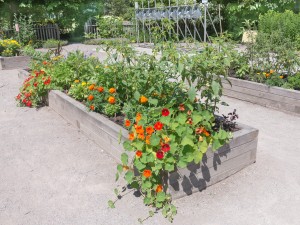Trending
Community Gardens: The dirt on a growing trend
March, 2016

Everywhere you look across the country, community gardens are sprouting up like grass through pavement. For those with a passion to turn vacant and sometimes-neglected land into an oasis of herbs and vegetables, food is never just food—it’s a source of health, a way to nurture the planet and a means to connect with each other. Whether in the backyards of schools or neatly tucked away in densely populated areas, these edible landscapes are living examples of what dedicated people can achieve when they work together. Here we explore the history of community gardens, size up their many benefits and discover how even the most inexperienced gardener can flourish like sweet peas in the summer sun.
‘Own’ Grown Goodness
Community gardening, also known as city farming, rooftop gardening and urban agriculture, can be done in a wide variety of places: vacant lots, city parks, schoolyards and in some parts of the world, vertically up the sides of buildings. And if you were going to force it to a definition, a community garden could simply be described as a single piece of land gardened collectively by a group of people. Oftentimes, that land is divided into plots, with each managed by a different gardener or family. The spaces themselves are as diverse as the plants grown on them. Some are hundreds of plots large, while others consist of only a few modest containers. As surging produce prices continue to burn holes in the wallets of Canadians, community gardening is becoming an attractive alternative even to those who have never grown a vegetable before.
Rooted in History
Community gardens are thought to have evolved from the European system of allotment gardens that first appeared around the 18th century due to urbanization and industrialization. Immigrants from these countries took the idea to North America where it became important for food security in poorer urban areas. Historically, urban community gardens have seen waves of popularity, most often providing food during times of war, periods of economic depression or when there are increased concerns about pesticide use in agriculture.
For Derrick Harrison, past president of the St. Albert & District Garden Club, gardens were a way of life growing up in England. “They’re a long-standing idea,” he says. “After the industrial revolution, a lot of people lived in cities where they had no garden whatsoever, and this was an opportunity for them to grow their own food,” Harrison explains. “If you go back [over] 150 years when St. Albert was founded, if you didn’t know how to garden and grow produce, you didn’t last many years because there was no railway and no supermarkets.” Sadly, Harrison agrees that with space at a premium in most residential neighbourhoods, coupled with the publics’ appetite for convenience, the average persons’ knowledge of gardening is very weak.
Harvesting the Benefits
A whole host of benefits exist for growing your own garden—well beyond dollars and cents. Taste is a big one. “What you grow always tastes better than what you buy,” says Harrison. “Commercially grown produce has to stand up to shipping,” he adds. In addition to tantalizing the taste buds and increasing the consumption of healthy food, urban gardens provide satisfying labour, neighbourhood improvement, a sense of community and connection to the environment. “It’s outdoor recreation […] it’s not just for older people […] it’s an appreciation of the work that is put into it—that things don’t simply pop up,” Harrison says.
St. Albert is currently home to five community gardens: St. Albert Community Garden, (located on the south side of Riel Drive), St. Albert Parish Heritage Garden (located on the north side of St. Vital Avenue), Gate Avenue Neighbourhood Garden (situated near the Christian Reformed Church), Meadowview Lane Community Plots and St. Albert Botanic Park Volunteer ‘Rows’ (which are available only to volunteers who have worked a designated number of hours in the park.) While many gardens are farmed on church land, others are cultivated on city and privately owned property. According to Harrison, nearly all of St. Albert’s community gardens have waiting lists. He is hopeful, however, that a sixth garden, located in Grandin, will be open for business in spring 2016.
Getting Schooled
Gardening as a trend isn’t taking root just in the community at large—it’s an idea that’s being transplanted to schools and classrooms across the country. Little Green Thumbs, an organization that offers an indoor gardening program to elementary and high-school students, has helped more than 250 schools across 4 provinces since 2007. One of those schools is St. Albert’s Muriel Martin Elementary School—home to an indoor garden where seedlings are started, and to an outdoor garden and greenhouse. Principal Les Kirchner says in addition to connecting to the science curriculum, it gives kids the chance to experience fresh, natural food that they’ve grown themselves. “A lot of these kids have never gardened before, so it gives them the experience of seeing the process from start to finish,” he says. A lot of vegetables that don’t need a lot of maintenance over the summer are planted at the school—potatoes, carrots, beets and tomatoes, to name a few. “The Grade 3s help me plant, and then I do a dinner with all the Grade 4s. At the beginning of the year, we have French fries and make a tomato sauce with macaroni,” he explains. “Doing it together, as a community, is really important for the kids, too.” Thanks in part to an environmental initiatives grant from the City of St. Albert in 2012, the school was able to build five outdoor gardening beds. Kirchner hopes one day to expand the idea to include the broader community, by setting up a larger outdoor garden close to the school.
Restaurants are also adopting a farm-to-plate philosophy that’s centred on using locally grown produce as much as possible. “If the Enjoy Centre has the capacity to grow tomatoes, cucumbers and herbs, we use those items in the restaurant,” says Julianna Mimande, general manager of St. Albert’s Glasshouse Bistro & Café. “Bill and Val [Hole] actually have a little acre where they grow produce. Whatever is in abundance, squash and peppers, for example, we take that into the bistro and process it,” she explains. According to Mimande, supporting local farmers or what she describes as “best-practice suppliers” helps income stay in the province, builds personal relationships and guarantees the best quality products.
Dig In & Get Your Hands Dirty
With a cornucopia of advantages, the popularity of community gardens has grown to the point where wait lists often exist. In response, the City of St. Albert is open to conversations about dedicating land for this purpose. “We would certainly consider it. It is not on the radar at this point for council, as no one is leading this initiative, but I am certain council would entertain the idea,” says City of St. Albert Mayor Nolan Crouse. According to Recreation Projects Coordinator Nicole Synowec, no set process exists for people who are interested in starting a community garden. However, “working with a community recreation coordinator or neighbourhood development coordinator are good places to start, as we can vet the enquiry through the appropriate channels and work with the individuals or groups from there,” she explains.
If you’re interested in joining or learning more about community gardens in the city, the St. Albert & District Garden Club website is also a great place to start. t8n
Did You Know?
In 2014, St. Albert’s Glasshouse Bistro & Café grew enough basil in the building’s greenhouse to preserve enough pesto for all of their pastas and salads in 2015.
According to Statistics Canada, vegetable prices soared 18.2% between January 2015 and January 2016. Lettuce costs 17.9% more, while tomatoes jumped 11.9%.
Did You Know?
A recent forecast by researchers at the University of Guelph learned that the average Canadian family of four spent roughly $350 more for the same basket of food in 2015 as they did in 2014.











